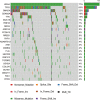Mutations in key driver genes of pancreatic cancer: molecularly targeted therapies and other clinical implications
- PMID: 33574569
- PMCID: PMC8563973
- DOI: 10.1038/s41401-020-00584-2
Mutations in key driver genes of pancreatic cancer: molecularly targeted therapies and other clinical implications
Abstract
Pancreatic ductal adenocarcinoma (PDAC) is one of the most lethal cancers, with a minimal difference between its incidence rate and mortality rate. Advances in oncology over the past several decades have dramatically improved the overall survival of patients with multiple cancers due to the implementation of new techniques in early diagnosis, therapeutic drugs, and personalized therapy. However, pancreatic cancers remain recalcitrant, with a 5-year relative survival rate of <9%. The lack of measures for early diagnosis, strong resistance to chemotherapy, ineffective adjuvant chemotherapy and the unavailability of molecularly targeted therapy are responsible for the high mortality rate of this notorious disease. Genetically, PDAC progresses as a complex result of the activation of oncogenes and inactivation of tumor suppressors. Although next-generation sequencing has identified numerous new genetic alterations, their clinical implications remain unknown. Classically, oncogenic mutations in genes such as KRAS and loss-of-function mutations in tumor suppressors, such as TP53, CDNK2A, DPC4/SMAD4, and BRCA2, are frequently observed in PDAC. Currently, research on these key driver genes is still the main focus. Therefore, studies assessing the functions of these genes and their potential clinical implications are of paramount importance. In this review, we summarize the biological function of key driver genes and pharmaceutical targets in PDAC. In addition, we conclude the results of molecularly targeted therapies in clinical trials and discuss how to utilize these genetic alterations in further clinical practice.
Keywords: CDKN2A; KRAS; SMAD4; TP53; clinical implication; pancreatic cancer.
© 2021. The Author(s), under exclusive licence to CPS and SIMM.
Conflict of interest statement
The authors declare that the research was conducted in the absence of any commercial or financial relationships that could be construed as potential competing interests.
Figures




References
-
- Siegel RL, Miller KD, Jemal A. Cancer statistics, 2019. CA Cancer J Clin. 2019;69:7–34. - PubMed
-
- Rahib L, Smith BD, Aizenberg R, Rosenzweig AB, Fleshman JM, Matrisian LM. Projecting cancer incidence and deaths to 2030: the unexpected burden of thyroid, liver, and pancreas cancers in the United States. Cancer Res. 2014;74:2913–21.. - PubMed
-
- Neoptolemos JP, Kleeff J, Michl P, Costello E, Greenhalf W, Palmer DH. Therapeutic developments in pancreatic cancer: current and future perspectives. Nat Rev Gastroenterol Hepatol. 2018;15:333–48.. - PubMed
-
- Maisonneuve P. Epidemiology and burden of pancreatic cancer. Presse Med. 2019;48:e113–e23.. - PubMed
Publication types
MeSH terms
Substances
LinkOut - more resources
Full Text Sources
Other Literature Sources
Medical
Research Materials
Miscellaneous

